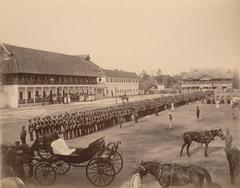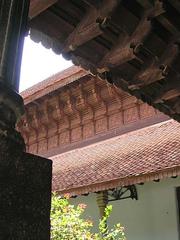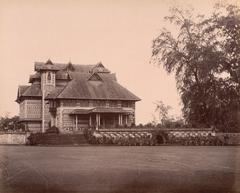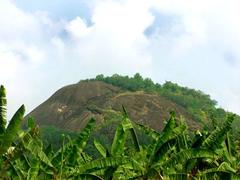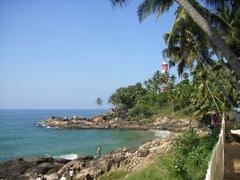Tropical Botanical Garden And Research Institute
Tropical Botanical Garden and Research Institute Thiruvananthapuram: Visiting Hours, Tickets, and Attractions
Date: 03/07/2025
Introduction: JNTBGRI’s Legacy and Significance
Located in the lush foothills of the Western Ghats at Palode near Thiruvananthapuram, Kerala, the Jawaharlal Nehru Tropical Botanic Garden and Research Institute (JNTBGRI) stands as one of Asia’s largest and most diverse tropical botanical gardens. Established in 1979 by the Government of Kerala, JNTBGRI is dedicated to scientific research, conservation, education, and tourism. The institute’s sprawling 300-acre campus houses over 50,000 plant accessions representing nearly 5,000 species—ranging from rare orchids and medicinal plants to palms, carnivorous plants, and unique Andaman Island flora.
JNTBGRI is internationally recognized for its pioneering ethnobotanical research, including impactful collaborations with indigenous communities such as the Kani tribe. These collaborations have led to innovations like the development of the herbal drug ‘Jeevani’ and sustainable benefit-sharing models. The institute’s robust conservation efforts include ex-situ and in-situ programs, seed banks, and cutting-edge biotechnology laboratories. For visitors, JNTBGRI offers accessible pathways, guided tours, educational workshops, seasonal events, and visitor amenities such as a cafeteria and souvenir shop. Its proximity to Thiruvananthapuram city and other major attractions makes it an essential stop for anyone interested in Kerala’s natural heritage (JNTBGRI official website, Kerala Tourism).
Quick Visitor Information
- Visiting Hours: 9:00 AM to 5:00 PM, Tuesday to Sunday (Closed on Mondays and public holidays)
- Ticket Prices:
- Adults: ₹50
- Children (below 12 years): Free
- Students/Senior Citizens: ₹25
- Location: Palode, approximately 35–40 km northeast of Thiruvananthapuram city center
- Accessibility: Wheelchair-accessible paths, ramps at key sites, and assistance for differently-abled visitors (advance notice recommended)
- Facilities: Visitor center, cafeteria, souvenir shop, ample parking, clean restrooms
Planning Your Visit
How to Reach
- By Road: Well connected via taxi and state-run buses from Thiruvananthapuram; drive time is about 1 hour.
- By Rail: Nearest station is Thiruvananthapuram Central.
- By Air: Trivandrum International Airport is roughly 40 km away.
Best Time to Visit
October to March offers the most pleasant weather and vibrant plant displays. Early mornings and late afternoons are ideal for photography and birdwatching.
Highlights and Attractions
Living Plant Collections & Themed Gardens
- Medicinal Plant Section: Hundreds of Ayurvedic and traditional medicinal species with informative signage.
- Orchidarium: Diverse collection including rare Malabar Daffodil Orchid.
- Palm Grove: Over 150 palm species from around the globe.
- Bamboo Collection: 73 varieties showcasing ecological and economic importance.
- Ginger Germplasm: 74 species vital for research and conservation.
- Andaman Species Conservatory: Rare and threatened flora from the Andaman Islands.
- Specialized Collections: Carnivorous plants, bonsais, ferns, cacti, succulents, gymnosperms, and more.
Conservation and Research Initiatives
- Ethnobotanical Research: Notably the ‘Jeevani’ drug, developed in partnership with the Kani tribe.
- Ex-situ/In-situ Conservation: Seed banks, tissue culture labs, and habitat restoration.
- Herbarium and Seed Bank: Over 51,000 specimens supporting research and education.
- Advanced Laboratories: For molecular biology, micropropagation, and biodiversity studies.
Visitor Facilities
- Guided Tours: Available on request, led by knowledgeable staff. Advance booking recommended.
- Educational Workshops: Regular events focusing on plant conservation, sustainable agriculture, and ethnobotany.
- Cafeteria: Serves refreshments and local snacks.
- Souvenir/Nursery Shop: Offers native plants and eco-friendly gifts.
- Rest Areas: Shaded spots and picnic zones throughout the garden.
Educational Outreach and Community Engagement
Structured Programs
- Project Work: 3-month (extendable) projects for students and researchers.
- Internships & Trainings: 1–6 months in areas like microbiology, systematics, horticulture, tissue culture, phytochemistry, ethnomedicine, and bioinformatics.
- Application & Fees: Online application required; fee structure ranges from ₹5,000 to ₹10,000/month depending on specialization (Training Details).
Community and Academic Partnerships
Collaborations with universities and community groups support student exchanges, workshops, and sustainable agriculture training.
Public Engagement
- Guided Educational Tours: Tailored for schools, colleges, and general visitors.
- Annual Events: Biodiversity Day, science fairs, and plant exhibitions draw thousands of participants annually.
Digital Resources & Virtual Outreach
- Virtual Tours: Experience JNTBGRI online via P4Panorama.
- Social Media: Updates and event news on Instagram, Facebook, and Twitter.
- Annual Reports and Plant Databases: Available for open access on the JNTBGRI website.
Nearby Attractions
Enhance your trip by visiting:
- Agasthyamalai Biosphere Reserve: Trekking and wildlife watching.
- Napier Museum & Zoo: Cultural and historical exhibits.
- Kanakakunnu Palace: Heritage architecture.
- Padmanabhaswamy Temple: Iconic religious site.
- Kovalam Beach: Popular for relaxation and water sports.
- Peppara & Neyyar Wildlife Sanctuaries: Rich in biodiversity.
Frequently Asked Questions (FAQ)
Q1: What are the JNTBGRI visiting hours?
A1: 9:00 AM to 5:00 PM, Tuesday to Sunday. Closed on Mondays and public holidays.
Q2: How much are tickets?
A2: Adults ₹50; students/seniors ₹25; children under 12 free.
Q3: Are guided tours available?
A3: Yes, with advance booking via the JNTBGRI website.
Q4: Is the garden accessible for differently-abled visitors?
A4: Yes. Most areas are accessible; assistance available upon request.
Q5: Are pets allowed?
A5: No, to protect sensitive plant and animal life.
Q6: Can I buy plants or souvenirs?
A6: Yes, at the nursery and gift shop.
Q7: Are refreshments available?
A7: Yes, at the on-site cafeteria.
Q8: How do I apply for training or internships?
A8: Through the JNTBGRI Trainings page.
Visuals and Media
Final Tips and Summary
JNTBGRI is a sanctuary of tropical plant diversity and a center for research, conservation, and community engagement. Its extensive collections, accessible facilities, and educational programs make it ideal for scientists, students, and tourists. Booking guided tours or workshops in advance is recommended for a richer experience. Leverage digital resources like virtual tours and the Audiala app for planning and interactive exploration.
The garden’s role in sustainable development, partnerships with indigenous communities, and proximity to Kerala’s top attractions ensure that every visit is meaningful and memorable. Explore JNTBGRI to discover the harmonious blend of nature, science, and culture in Kerala (JNTBGRI official website, P4Panorama virtual tour).
Sources and Further Reading
- This article draws upon official information and visitor resources from:



